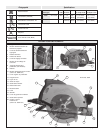
page 7
Adjusting Bevel Angle (Fig. 6 & 7)
1. Unplug tool.
2. To adjust the angle of the cut, hold the saw by the Tilt-Lok™ handle
and loosen the bevel adjusting lever by lifting it up towards the
blade (Fig. 6).
Adjusting Tilt-Lok™ Handle Angle (Fig. 8 & 9)
This circular saw is equipped with an adjustable handle. The Tilt-Lok™
feature allows the user to adjust the angle of the handle for optimum
cutting positions.
1. Unplug tool.
2. Press and hold the handle lever release button in.
3. Loosen the handle release lever by lifting it up and away from the Tilt-
Lok™ handle (Fig. 8).
NOTE: The blade depth setting will determine the range of Tilt-Lok™
positions available for the application. See “Adjusting Depth” for in-
structions on adjusting the blade depth.
5. Push the handle release lever back into the handle until it snaps into
place.
NOTE: The saw will not operate if the handle release lever is not
properly secured.
Adjusting the Blade to Shoe (Fig. 10 & 11)
The shoe has been adjusted at the factory to a 90 degree setting.
Inspect the saw regularly to make sure the blade is 90 degrees to the
shoe.
1. Unplug tool.
2. Set the bevel pointer to zero (Fig. 10).
WARNING!
Do not operate saw with handle lever release
button pressed in or with handle not locked into
position.
WARNING!
If the Tilt-Lok™ handle moves with the handle
release lever in the locked position, do not operate
saw. Return the circular saw to a
MILWAUKEE
ser-
vice facility for repair immediately.
3. Hold the front handle and rotate the saw by the Tilt-Lok™ handle to
the desired angle as indicated by the markings on the bevel scale
(Fig. 7).
4. To adjust the handle position, hold the front handle and rotate the Tilt-
Lok™ handle to the desired angle as indicated by the handle rotation
adjustment markings (Fig. 9). The Tilt-Lok™ feature has eight (8)
detents which allow the handle to snap into position. Allow the detent
to snap into place.
Fig. 9
Fig. 10
4. Move the bevel adjusting lever away from the blade and push down
to secure the position.
Fig. 6
Fig. 7
Fig. 8


















